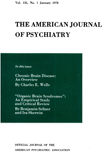CLINICAL STUDIES ON a-(2-PIPERIDYL) BENZHYDROL HYDROCHLORIDE, A NEW ANTIDEPRESSANT DRUG
Abstract
1. The pharmacology of a new antidepressant drug, Meratran, is reviewed briefly.
2. Clinical trial in 320 cases disclosed that the therapeutic indications of this compound are roughly similar to those of the amphetamines.
3. Reactive depressions responded effectively in 90% of our relatively small series.
4. Endogenous depressions responded favorably in 65% of our cases.
5. The drug has proved valuable in office practice because the appetite loss and the cardiovascular pressor reactions sometimes observed after the administration of the amphetamines are not encountered. In addition the drug seldom interferes with nocturnal sleep, and when it produces anxiety side reactions these are less severe and less disturbing subjectively than those encountered with the amphetamines.
6. When anxiety or agitation comprise a sizable proportion of the clinical picture the drug should be used with caution.
7. Preliminary observations indicate that the drug may have therapeutic usefulness, in addition to the depressive states, in some of the tics, in narcolepsy, and as an adjunct in the management of certain epileptics.
8. Effective dosage ranges (except in narcolepsy) vary between 3.0 and 25.0 mg. daily.
9. Wider clinical trial of this compound appears justified.
Access content
To read the fulltext, please use one of the options below to sign in or purchase access.- Personal login
- Institutional Login
- Sign in via OpenAthens
- Register for access
-
Please login/register if you wish to pair your device and check access availability.
Not a subscriber?
PsychiatryOnline subscription options offer access to the DSM-5 library, books, journals, CME, and patient resources. This all-in-one virtual library provides psychiatrists and mental health professionals with key resources for diagnosis, treatment, research, and professional development.
Need more help? PsychiatryOnline Customer Service may be reached by emailing [email protected] or by calling 800-368-5777 (in the U.S.) or 703-907-7322 (outside the U.S.).



